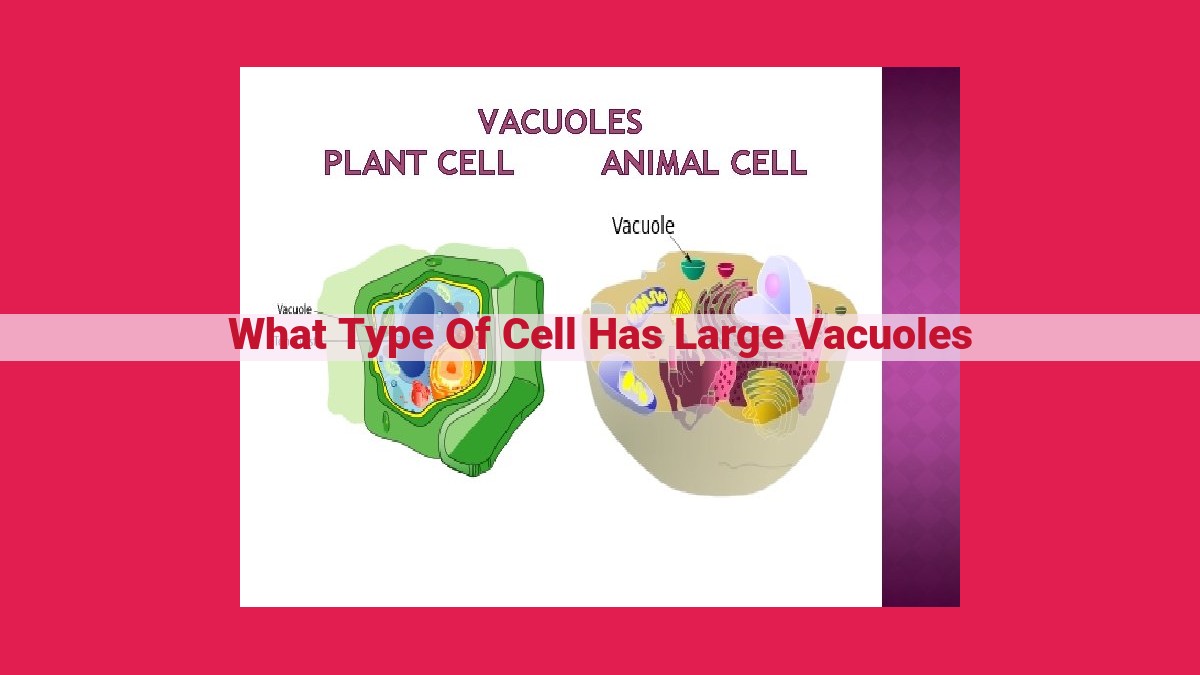Plant Vacuoles: Essential For Plant Structure, Function, And Adaptation

Plant cells possess large vacuoles, membrane-bound compartments that occupy a significant portion of their volume. These vacuoles serve multiple functions: they maintain turgor pressure, which gives plants structural support, and they compartmentalize waste products, ensuring cellular integrity. The presence of large vacuoles is a distinguishing characteristic of plant cells and reflects their specialized adaptations for growth, development, and response to environmental cues.
Understanding Plant Cells: The Building Blocks of Plant Life
In the vast and intricate world of nature, plants stand tall as pillars of life, anchoring ecosystems and providing sustenance for countless organisms. At the heart of every plant lies the humble yet remarkable plant cell, a microscopic marvel that orchestrates a symphony of functions essential for plant survival.
Definition and Characteristics
Plant cells are specialized units that share unique characteristics distinguishing them from their animal counterparts. They are typically larger, with a distinct cell wall surrounding the cell membrane. This rigid structure provides support and protection, allowing plants to withstand changes in their environment.
Key Structures: Cell Wall, Nucleus, and Golgi Apparatus
Within the plant cell, several key structures play crucial roles. The cell wall acts as a protective barrier, preventing the cell from bursting due to the pressure exerted by the large central vacuole. The nucleus, the control center of the cell, houses the genetic material (DNA) that guides the cell’s activities. The Golgi apparatus, a membrane-bound organelle, processes and modifies proteins before they are secreted from the cell.
Large Vacuoles: A Plant Cell’s Secret Weapon
In the realm of plant cells, vacuoles reign supreme as spacious compartments that play a pivotal role in their survival. Picture a vast, fluid-filled sac within the plant cell, enclosing a range of vital substances.
These organelles perform a multifaceted role:
Turgor Pressure Maintenance: The vacuole’s turgid state is crucial for plant cells. By exerting outward pressure, it keeps the cell firm and prevents it from collapsing. This is especially important in non-woody plants, which lack sturdy cell walls.
Waste Compartmentalization: Vacuoles serve as a storage facility for metabolic waste products, isolating them from the rest of the cell. This process helps maintain cellular homeostasis and protects against potential damage.
Additional Benefits:
- Nutrient Storage: Vacuoles can store essential nutrients for the plant, such as sugars, amino acids, and ions.
- Pigment Storage: Some vacuoles contain pigments, giving plants their distinctive colors.
- Defense Mechanism: Vacuoles may contain toxins or enzymes that act as a defense mechanism against pathogens or herbivores.
The Role of Other Plant Cell Structures
Beyond the vacuoles, other plant cell structures play equally crucial roles in sustaining their unique functions and ensuring overall plant survival.
Photosynthesis and Chloroplasts: The Energy Conversion Centers
The presence of chloroplasts sets plant cells apart. These organelles are the powerhouses responsible for photosynthesis, the magical process that converts sunlight into energy. Within the chloroplasts, chlorophyll, a green pigment, absorbs sunlight, initiating a series of reactions that ultimately produce glucose for energy and release oxygen as a byproduct.
Communication and Transport: The Cytoplasm and Membrane-Bound Compartments
The fluid-filled cytoplasm is the bustling hub of the cell, facilitating communication and transport. _Membrane-bound compartments like the *endoplasmic reticulum* and *Golgi apparatus* coordinate protein synthesis and secretion.
Microtubules and microfilaments, the cytoskeleton’s building blocks, provide structural support, ensuring the cell’s shape and facilitating intracellular movement.